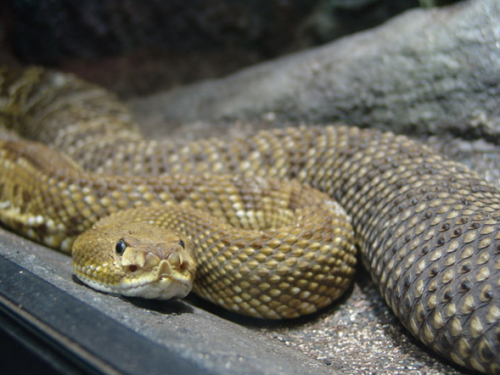Researcher studies small mammals' strategies for avoiding snakebites

When I asked SDSU biology professor and snake researcher Rulon Clark to show me where he keeps the snakes, I didn't know what to expect. I know I didn't expect an unmarked door in a building basement. I didn't expect Tupperware shelves, each plastic bin sliding out to reveal its reptilian resident. And I certainly didn't expect to hear an immediate thsssk-sk-sk-sk-sk-sk as I stepped into the room.
"Am I—am I being rattled at?" I asked, mentally gauging the plastic separating me from the sound to be maybe a sixteenth of an inch thick.
"Yes," Clark said. "That's one of our rattlesnakes. He's just letting you know he's there."
Oh yes. I was quite aware of him.
"Sometimes when you're working down here, you'll hear them lunging and hitting the plastic. Thunk, thunk," he said.
In the reptile room, there are 11 rattlers of various kinds, dozens of harmless garter snakes, a few other odd species of snake—some venomous, some not—and also quite a few lizards. These snakes live a pretty good life with all the food, shelter and safety they could ever want.
In turn, they help Clark and his colleagues figure out the defensive strategies employed by small mammals that in the wild try to avoid the unpleasantness of becoming prey.
Evolutionary fear
Despite more than a decade of hands-on work with snakes, Clark has never been bitten. "I'm very careful," he said, adding that people's fear of snakes is way out of proportion with their actual risk.
"Being bitten is a very, very, very rare scenario," Clark said. "Snakes will only bite a human defensively. You're a bigger, scarier animal than they are. They only want you to get out of the way so they can hunt mice in peace."
So why are we so afraid of them? It's an unfortunate holdover from our evolutionary past, he explained.
"We evolved with the danger of venomous snakes, even though they no longer pose much of a threat to us," Clark said. "We didn't evolve with cars and cupcakes and the things that actually kill us."
Split-second survival
Back in his office, where the only snakes are the ones in poster pictures and on the "Don't Tread On Me" flag hanging in his window, Clark tells me more about his research.
Recently, he and his graduate student Bree Putman (snake tattoo, wrist) published an article in the journal Behavioral Ecology looking into how ground squirrels evade snake bites. Trying out several different experimental conditions with the help of high-speed cameras, they discovered that when ground squirrels suspect there might be a snake nearby, they prepare to cartwheel out of the way at a moment's notice, bodies twirling and tails spinning to confuse the striking snake.
Clark, Putman and another colleague are just beginning a new line of research examining another desert-dweller, the kangaroo rat, which pulls a similar trick, but possibly even more effectively. The kangaroo rat's leap springs it two to three feet into the air—about five to six times its body length. It happens in a split second, Clark said, and it very quickly takes the rat out of the snake's strike range.
"That's like you or me jumping on top of a three-story building," he said.
Journal information: Behavioral Ecology
Provided by San Diego State University




















